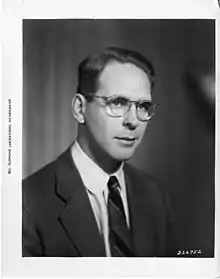Conyers Herring | |
|---|---|
 Herring in 1959 | |
| Born | William Conyers Herring November 15, 1914 Scotia, New York, U.S. |
| Died | July 23, 2009 (aged 94) Palo Alto, California, U.S. |
| Alma mater | Princeton University |
| Known for | Weyl semimetal Nabarro–Herring creep Holstein–Herring method |
| Awards |
|
| Scientific career | |
| Fields | Physics |
| Institutions | |
| Thesis | On Energy Coincidences in the Theory of Brillouin Zones (1937) |
| Doctoral advisor | Eugene Wigner |
William Conyers Herring (November 15, 1914 – July 23, 2009) was an American physicist. He was a professor of applied physics at Stanford University and the Wolf Prize in Physics recipient in 1984/5.[1]
Academic career
Conyers Herring completed his Ph.D. in physics from Princeton University in 1937, submitting a dissertation entitled On Energy Coincidences in the Theory of Brillouin Zones under the direction of Eugene Wigner. In 1946, he joined the technical staff of Bell Laboratories in Murray Hill, New Jersey, where he remained until 1978. Then, he joined the faculty at Stanford University.
Contributions
Conyers Herring played a major role in the development of solid state physics.
He laid the foundations of band structure calculations of metals and semiconductors, culminating in the discovery of the Orthogonalized Plane Wave Method (O.P.W.) in 1940. He was years ahead of his time in this contribution. A great deal of modern solid state physics as produced today stems from this original and early paper.
In 1937, he predicted the existence of Weyl semimetal, materials that display Weyl quasiparticles, which were experimentally demonstrated in 2015.[2]
His influence on the development of solid state physics extends to a deep understanding of many facets such as surface physics, of thermionic emission, of transport phenomena in semiconductors and of collective excitations in solids such as spin waves.
He created the theoretical physics division at Bell Telephone Laboratory. Because of this, the total research effort at this institution and brought about much of the most original research in condensed matter physics during the latter half of the 20th century.
He has also been most influential in promoting international cooperation among scientists and through his character and his personal example, he has exemplified a somewhat unattainable ideal of how a research scholar in any field should operate.
He has contributed to religion and science discussions. He has stated about God that "Things such as truth, goodness, even happiness, are achievable by virtue of a force that is always present, in the here and now and available to me personally".[3]
Brain box
Herring was famously well-read in the physics literature, and summarized references he found valuable on 3-by-5-inch (76 by 127 mm) index cards. He stored these cards, cataloged by topic, in a black suitcase that he referred to as his "brain box". Started in his student days, the brain box grew throughout his career, eventually containing 15,000 index cards with over 100,000 references.[4] A project to digitize the brain box was undertaken by Robert B. Laughlin after Herring's death.[5]
Awards and honors
In June 1954 he was one of twenty scientists under the age of forty identified by Fortune Magazine as "top young scientists in U. S. universities and industry".[6] In 1984/85 Conyers Herring was awarded the Wolf Prize in Physics along with Philippe Nozieres for "their major contributions to the fundamental theory of solids, especially of the behaviour of electrons in metals".[7] In 1980 he was awarded the NAS Award for Scientific Reviewing from the National Academy of Sciences.[8]
See also
References
- ↑ Conyers Herring at Stanford University
- ↑ Vishwanath, Ashvin (2015-09-08). "Where the Weyl Things Are". APS Physics. Vol. 8. p. 84. Bibcode:2015PhyOJ...8...84V. doi:10.1103/Physics.8.84.
- ↑ pages 42-44 of Margenau, H. (1992). Cosmos, Bios, Theos: Scientists Reflect on Science, God, and the Origins of the Universe, Life, and Homo sapiens. Open Court Publishing Company. co-edited with Roy Abraham Varghese. This book is mentioned in the Time magazine article: Galileo And Other Faithful Scientists
- ↑ Anderson, Philip; Geballe, Theodore; Harrison, Walter. "W. Conyers Herring, 1914-2009" (PDF). National Academy of Sciences. Retrieved 29 October 2023.
- ↑ Laughlin, Robert. "Herring Brain Box". Archived from the original on 17 May 2023. Retrieved 29 October 2023.
- ↑ "Young Scientists" (PDF). The Month at Caltech. June 1954. p. 23.
- ↑ "The Wolf Prize in Physics in 1984/85". Archived from the original on 2012-02-05. Retrieved 2007-07-30.
- ↑ "NAS Award for Scientific Reviewing". National Academy of Sciences. Archived from the original on 18 March 2011. Retrieved 27 February 2011.
External links
- Conyers Herring at the Mathematics Genealogy Project
- Profile of Conyers Herring
- The contributions of Conyers Herring
- Oral History interview transcript with Conyers Herring 5 August 2000, American Institute of Physics, Niels Bohr Library and Archives Archived 4 June 2011 at the Wayback Machine
- Oral History interview transcript with Conyers Herring 23 July 1974, American Institute of Physics, Niels Bohr Library and Archives Archived 4 June 2011 at the Wayback Machine
- Stanford Obituary of Conyers Herring
- National Academy of Sciences Biographical Memoir